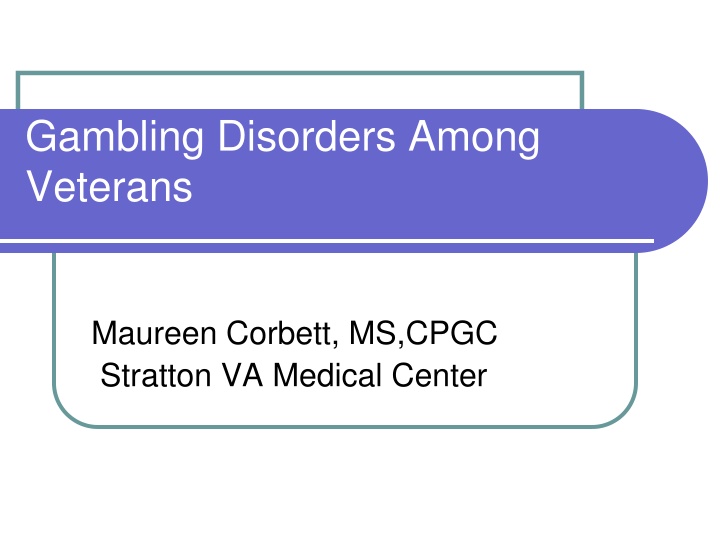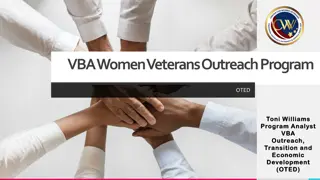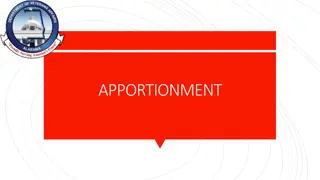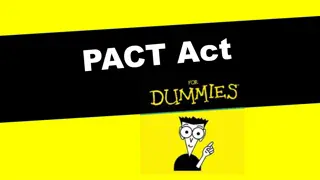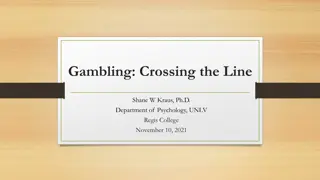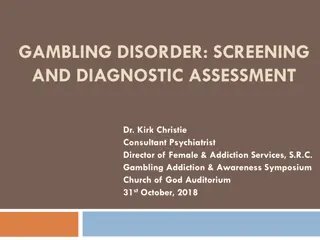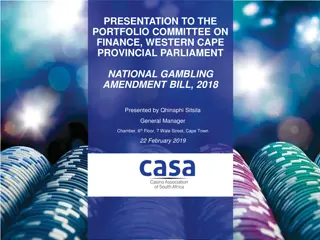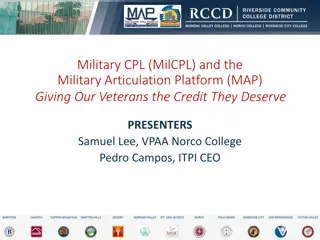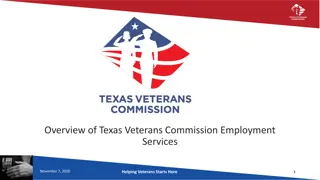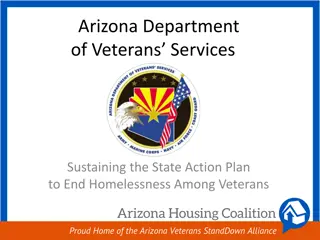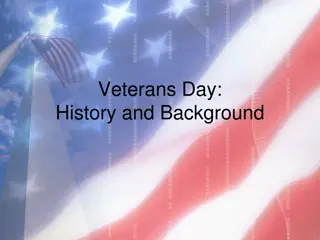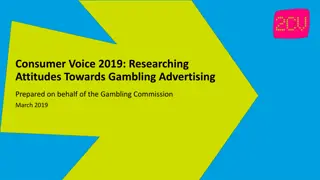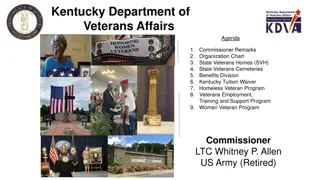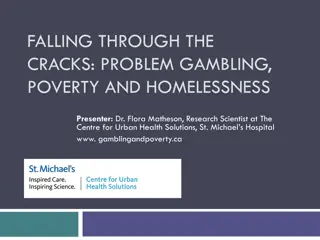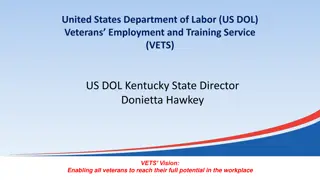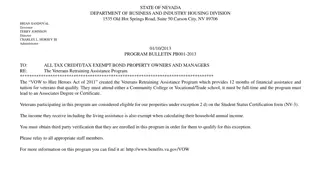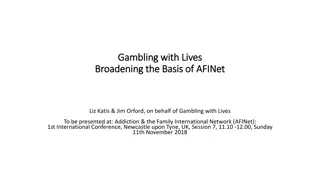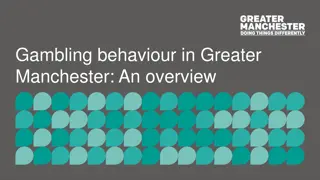Gambling Disorders Among Veterans: Understanding the Impact
Veterans may struggle with gambling disorders, a recognized diagnosis with serious consequences for individuals and their loved ones. The disorder, characterized by uncontrollable urges and financial harm, shares neurocircuitry similarities with substance addiction. Despite causing hidden addictions and significant financial problems, gambling disorders are often overlooked and challenging to address, with fewer resources available compared to drug prevention efforts. Studies have shown a prevalence of approximately 3.9% of adults in the United States, highlighting the need for greater awareness and support for those affected.
Download Presentation

Please find below an Image/Link to download the presentation.
The content on the website is provided AS IS for your information and personal use only. It may not be sold, licensed, or shared on other websites without obtaining consent from the author.If you encounter any issues during the download, it is possible that the publisher has removed the file from their server.
You are allowed to download the files provided on this website for personal or commercial use, subject to the condition that they are used lawfully. All files are the property of their respective owners.
The content on the website is provided AS IS for your information and personal use only. It may not be sold, licensed, or shared on other websites without obtaining consent from the author.
E N D
Presentation Transcript
Gambling Disorders Among Veterans Maureen Corbett, MS,CPGC Stratton VA Medical Center
DSM-5 Moved from Impulse Control Disorder to Substance Related and Addictive Disorders. Changed from Pathological Gambling to Gambling Disorder. Researchers found that gambling is a disorder of the brain s reward system as are substance addictions. During brain-imaging studies, the same brain areas are activated in response to cues for either gambling or substance addictions, indicating they share the same neurocircuitry.
Gambling Disorder Defined First recognized as diagnosable disorder in the DSM in 1980 Is progressive Is characterized by psychologically uncontrollable urges Can damage family, social and vocational interests
Characteristics of a Gambling Disorder Preoccupied with gambling Needing to gamble with increasing amounts of money to achieve the same excitement Repeated unsuccessful efforts to control, cut back or stop gambling Is restless or irritable when attempting to cut down or stop Gambles as a way of escaping problems After losing money gambling often returns another day to get even (chasing losses) (DSM-5, American Psychiatric Association)
Characteristics Continued Gambling is a hidden addiction As long as there is money, overdose is not possible No urine screens for gambling No ingestion of chemicals Gambling not usually perceived as a disorder
Characteristics Continued Fewer resources available for those negatively affected by Gambling Gambling can cause tremendous financial problems Problem gamblers are usually functioning at work Gambling prevention message not as easily accepted as drug prevention message
Gambling Disorder Prevalence Approximately 3.9% of adults in the United States or 6 and a half million people are believed to have a gambling disorder (NCPG 2014) In a NYS prevalence study 5% of adults met the criteria for a gambling disorder which is approximately one million adults (NYCPG 2006)
Prevalence Rates for Veterans Higher than general population Gambling Disorder rate among Veterans estimated to be 8.1% Active duty personnel estimated to meet the criteria for a gambling disorder 36,000-48,000 (Gambling and Health Risk Taking Behavior in the Military, Steenbergh,et al, 2008 Military Medicine) Veterans with substance abuse disorder are 6 times more likely to have a gambling disorder with 33% meeting the criteria 17% of Veterans entering treatment for PTSD also met the criteria for a gambling disorder (Biddle, D. Journal of Traumatic Stress (2005
Relationship Between Gambling Disorder and Alcohol/Substance Abuse Between 30-50% of clients seeking treatment for problem gambling have a co-existing alcohol or substance abuse disorder Many clients note they are able to maintain abstinence from drug/alcohol problems replacing it with gambling Many clients reported not being screened for gambling problem while in SA treatment, (Pathological Gambling In Hospitalized Substance Abusing Veterans). Daghestani, A. Journal of Clinical Psych (1996)
Gambling and Substance Abuse Continued Resembles dependence on physical substance Symptoms similar relief with use, withdrawal and preoccupation Social, family and occupational consequences are similar
Gambling and Substance Abuse Continued Relapse is a clinical issue for both Motivation to change impacts treatment outcomes Need to learn coping skills for high risk situations Successful treatments include 12-Step, motivational interviewing, cognitive behavioral therapies For individuals with Alcoholism and gambling disorders, addressing both problems simultaneously lead to better outcomes (Hodgins and el-Guebaly, 2002)
Suicide and Gambling Problem Gamblers have the highest rate of suicide twice the rate of than any other addiction 1 in 5 problem gamblers have attempted suicide 40% of Veterans seeking treatment for gambling problems reported a suicide attempt (Biddle D. Journal of Traumatic Stress (2005)
History of Gambling in the Military Slot machines have been on some military bases since the 1930s In 2005 there was 2 billion dollars gambled and 120 million dollars of revenue from military base slot machines Army bingo in 2005- 45 million dollars gambled 3,000 slot machines at military installations overseas Casinos in close proximity to bases Nellis Air Force Base Las Vegas, Camp Pendleton, Kessler AFB Biloxi Social gambling and poker in barracks (NCPG)
Military Culture and Gambling Close quarters time spent together, i.e. gambling on a ship readily available during downtime Characteristics of military personnel risk takers sensation seekers Young unmarried men more at risk Relieves boredom and social isolation Fills a void and elevates mood Viewed as supplementing income Meets need for competition Used to cope with trauma gambling as an escape and numbing of uncomfortable feelings
Unique Characteristics Veterans report simulates risk involved in combat putting everything on the line similar to the risk of betting it all Female Veterans With Military Sexual Trauma Veterans returning from deployment may be at greater risk especially when exposed to combat and traumatic experiences Younger Veterans more likely sports gamblers
Similarities with General Population More similarities than differences Problem Gambling under reported Correlation between trauma and addiction Usually seek help when crisis has occurred Same treatment modalities used MI, CBT, Self Help
Treating Veterans with Gambling Disorders MI Approach May be the first time Veteran has discussed the problem need to be sincere and understanding Feelings of shame can be a barrier to treatment Limited treatment available in the military Concerns about confidentiality and promotion are a barrier to seeking treatment in the military Gambling treatment counselors not always available Helping the Veteran understand that gambling is a behavior that can be changed with motivation, support and treatment Instilling hope
Treatment Continued Cognitive Behavioral Therapy Gambling is a heady addiction Helping the Veteran to identify thoughts that lead to gambling often they are thinking only about the possibility of winning Discussing the odds of winning helping them to focus on the reality of gambling
Treatment Continued Identifying high risk situations and the thoughts that lead to gambling Helping the Veteran to identify new thoughts and behaviors to better cope with urges to gamble Slowing down thinking and raising awareness of the impact of gambling in their lives
Treatment Continued Group support very helpful Many Veterans have reported that being in a group with other Veterans has been very therapeutic for them GA self-help groups
Treatment Provided by VA Some Outpatient Programs Inpatient facility Brecksville, Ohio 28 day program 12 beds Ohio program serves 100-120 Veterans and their families per year 99% of Veterans come from across the country for treatment
Questions to Ask How much do you gamble? Important to ask many gamblers and family members do not come forward with the problem Don t think it is a problem and do not know how to get help Have you ever tried to stop or cut down on your gambling? Has anyone ever been worried about your gambling? Do you hide betting slips, tickets, money to conceal the amount you are gambling? Have you ever lied about the extent of your gambling?
References Bray, R. M. Sanchez R.P. Ornstein, M.L. Lentine, D. Vincus, A. A. Baird T. V. Lannacchione, V. G. (1998). Department of Defense Behaviors Among Military Personnel (Biddle, D. Journal of Traumatic Stress (2005) DSM-V, American Psychiatric Association 2015 Gambling and Health Risk Taking Behavior in the Military, Steenbergh,et al, 2008 Military Medicine Minnesota Department of Human Services, Problem Gambling the Hidden Addiction Najavits, L.M. (2011). Treatment for PTSD and Pathological Gambling: What do Patients Want? Journal of Gambling Studies National Council on Problem Gambling New York Council on Problem Gambling Pathological Gambling In Hospitalized Substance Abusing Veterans). Daghestani, A. Journal of Clinical Psych (1996) Tucker, J.H., (2012) Military Has a Gambling Problem. Seattle News.
Substance Use Disorders and PTSD among Veterans Devon Cummings, Ph.D. Stratton VA Medical Center
SUD Statistics 2013 National Survey on Drug Use & Health indicated that 1 in 15 Veterans had a SUD in the past year This rate was higher for OEF/OIF Veterans Within VHA, trends in SUD diagnoses over time have been evaluated Alcohol remains the most commonly diagnosed SUD Cannabis and opiates have increased in recent years
PTSD statistics There are over 2.7 million American OEF/OIF/OND Veterans Sevcik, 2016 Prevalence of PTSD in general population: 4% Caused by natural disasters, accidents, assault, etc. Approximately 55% of OEF/OIF/OND Veterans who use VHA services have been diagnosed with PTSD Sevcik, 2016 Rates of post-traumatic stress are greater for these wars than prior conflicts
SUD & PTSD Statistics Patients seeking treatment for PTSD are up to 14 times more likely than those without PTSD to have a SUD McCauley et al., 2012
VHA SUD & PTSD Statistics The prevalence of co-occurring PTSD/SUD in Veterans seeking treatment in VHA increased 76% between FY08 and FY13 Drexler, 2016 Of OEF/OIF Veterans who enrolled in VA care between 2001 and 2009 and were diagnosed with a SUD, 55%-75% were also diagnosed with PTSD or depression VA/DoD SUD Practice Guidelines, 2015 Increased mortality rate for Veterans who have co-occurring PTSD and SUD VA/DoD SUD Practice Guidelines, 2015
SUD & PTSD Co-occurring PTSD and SUD is more difficult and costly than either diagnosis alone (McCauley et al., 2012; Browne et al., 2016; Coker, Stefanovics, & Rosenheck, 2016; Haller et al., 2016) Increased chronic physical health problems Poorer social functioning Higher rates of suicide attempts More legal problems Increased risk of violence Worse treatment adherence Less improvement during treatment
OEF/OIF Veterans with SUD/PTSD OEF/OIF Veterans diagnosed with PTSD are significantly more likely to receive opiates for pain, higher doses of opiates, two or more opiates, sedative hypnotics concurrent with opiates, and to obtain early refills Seal et al., 2012
Treating SUD & PTSD: Traditional Views Treating PTSD before achieving sobriety is highly risky Treatment of PTSD without sobriety increases risk of re-traumatizing the patient Treatment of substance use should be prioritized over treatment of PTSD Patients should not be treated for PTSD if they are currently abusing substances SUD is an exclusion criteria for treating PTSD; conversely, patients with SUDs are not routinely assessed for PTSD
Treating SUD & PTSD: Emerging View Previous assumptions more anecdotal, not actually that well-investigated Treating co-occurring PTSD & SUD can happen in either order or concurrently Evidence-based protocols can be used with persons who have active SUDs Cognitive Processing Therapy well- tolerated with Alcohol Use Disorders (Kaysen et al., 2014) Treating SUD without treating PTSD increases the risk of relapse and fails to address underlying problem SUD patients should routinely be screened for PTSD
Integrative treatment Questions to ask: Psychosocial/socioeconomic stability? Are there other forms of support? Are there other eyes on the person? Risk of harm to self or others? Treatment Protocols Seeking Safety (Najavits, 2002) Concurrent Treatment of PTSD and Substance Use Disorders Using Prolonged Exposure (COPE; Mills et al., 2012) Integrated Cognitive-Behavioral Therapy (ICBT; e.g., McGovern et al., 2011; Haller et al., 2016) Cognitive Processing Therapy with substance relapse prevention (Haller et al., 2016) Simultaneous bi-modal treatment Many other integrated or combined interventions under trial as of 2015
VHA Practice Recommendations for Comorbid SUD and PTSD Facilitate comprehensive assessment and diagnosis of both PTSD & SUD in both PTSD and SUD settings Create an integrated, concurrent treatment plan Clinical judgment is needed to decide on specific treatments to implement, for which patients, and under which treatment conditions Employ effective first-stage treatment strategies, such as MI and Seeking Safety Conduct systematic treatment response monitoring using measures such as the Brief Addiction Monitor (BAM) and PTSD Checklist (PCL) Consider integrated PTSD/tobacco cessation treatment when indicated Employ a SUD/PTSD Specialist whose role is to coordinate treatment planning and service delivery for Veterans who have comorbid SUD and PTSD Serves as a functional member of both PTSD and SUD teams Educates other providers about PTSD, SUD, screening for such, and referral to appropriate services
EXAMPLE: Seeking Safety Twelve-session abbreviated protocol (Hien et al., 2012) Modified for Veteran population: Quotations sometimes useful, sometimes not Some groups more psychoeducational, other groups more processing ( processing-lite ) Both combat and mixed groups Substantial flexibility Good attendance, high retention!
Teaming Up: PTSD & SUD Programs Working Together Coordinated approach between both programs Highly individualized for Veterans who have unique or significant needs Regular communication and collaboration Closes gaps in service Avoids duplication of services and back-and- forth between programs Improves access and quality of care
References Browne, K. C., Wray, T. B., Stappenbeck, C. A., Krenek, M., & Simpson, T. L. (2016). Alcohol consumption, craving, and craving control efforts assessed daily in the context of readiness to change among individuals with alcohol dependence and PTSD. Journal of Substance Abuse Treatment, 61, 34-41. http://dx.doi.org/10.1016/j.jsat.2015.09.005 Coker, K. L., Stefanovics, E., & Rosenheck, R. (2016). Correlates of improvement in substance abuse among dually diagnosed veterans with post-traumatic stress disorder in specialized intensive VA treatment. Psychological Trauma: Theory, Research, Practice and Policy, 8, 41-48. http://dx.doi.org/10.1037/tra0000061 Drexler, K. (2016). How are we doing? Evidence-based practices in substance use disorder treatment [PowerPoint Slides]. Retrieved from the Department of Veterans Affairs: www.va.gov Haller, M., Norman, S. B., Cummins, K., Trim, R. S., Xu, X., Ruifeng, C., et al. (2016). Integrative cognitive behavioral therapy for adults with depression, substance use disorder, and trauma. Journal of Substance Abuse Treatment, 62, 38-48. http://dx.doi.org/10.1016/j.jsat.2015.11.005 Hien, D. A., Morgan-Lopez, A. A., Campbell A. N. C., Saavedra, L. M., Wu, E., Cohen, L. R., et al. (2012). Attendance and substance use outcomes for the seeking safety program: Sometimes less is more. Journal of Consulting and Clinical Psychology, 80, 29-42. http://psycnet.apa.org/doi/10.1037/a0026361
References Kaysen, D., Schumm, J., Pedersen, E. R., Seim, R. W. Bedard-Gilligan, M., & Chard, K. (2014). Cognitive processing therapy for veterans with comorbid PTSD and alcohol use disorders. Addictive Behaviors, 39, 420-427. doi: 10.1016/j.addbeh.2013.08.016 McCauley, J. L., Killeen, T., Gros, D. F., Brady, K. T., & Back, S. E. (2012). Posttraumatic stress disorder and co-occurring substance use disorders: Advances in assessment and treatment. Clinical Psychology, 19, 283-304. doi: 10.1111/cpsp.12006 McGovern, M. P., Lambert-Harris, C., Alterman, A., Xie, H., & Meier, A. (2011). A randomized controlled trial comparing integrated cognitive behavioral therapy versus individual addiction counseling for co-occurring substance use and posttraumatic stress disorders. Journal of Dual Diagnosis, 7, 207 227. doi: 10.1080/15504263.2011.620425 Mills, K. L., Teesson, M., Back, S. E., Brady, K. T., Baker, A. L., Hopwood, S., et al. (2012). Integrated exposure-based therapy for co-occurring posttraumatic stress disorder and substance dependence: A randomized controlled trial. JAMA, 308, 690-699. doi: 10.1001/jama.2012.9071 Najavits, L. M. (2001). Seeking safety: A treatment manual for PTSD and substance abuse. New York, NY: Guilford Press. National Center for PTSD. (2010, March). Report of (VA) consensus conference: Practice recommendations for treatment of veterans with comorbid substance abuse and PTSD. Retrieved February 25, 2016, from http://www.ptsd.va.gov/professional/pages/handouts- pdf/SUD_PTSD_Practice_Recommend.pdf
References Seal, K. H., Shi, Y., Cohen, G., Cohen, B. E., Maguen, S., Krebs, E. E., & Neylan, T. C. (2012). Association of mental health disorders with prescription opioids and high-risk opioid use in U.S. veterans of Iraq and Afghanistan. JAMA, 307, 940-947. doi: 10.1001/jama.2012.234 Sevcik, J. (2016). Addressing substance use treatment needs [PowerPoint Slides]. Retrieved from www.vapulse.net Substance Abuse and Mental Health Services Administration. (2014, September). Results from the 2013 National Survey on Drug Use and Health: Summary of National Findings, NSDUH Series H-48, HHS Publication No. (SMA) 14-4863. Retrieved June 4, 2016 from http://www.samhsa.gov/data/sites/default/files/NSDUHresultsPDFWHT ML2013/Web/NSDUHresults2013.pdf U.S. Department of Veteran Affairs and Department of Defense. (2015, December). VA/DoD clinical practice guideline for the management of substance use disorders. Retrieved May 9, 2016 from http://www.healthquality.va.gov/guidelines/MH/sud/VADoDSUDCPGRev ised22216.pdf
Chemical Dependency Rehabilitation Program (CDRP) at Stratton VAMC Outpatient Programming SAMHSA s Matrix Model: Early Recovery Skills & Relapse Prevention Veterans participate in outpatient programming for approximately 6 months to one year, depending on their needs Process groups, psychoeducation, & family programming are offered ACT group for those who have participated in multiple levels of care, multiple times, without a significant change in symptoms Veterans have enjoyed this group and report that it is more helpful because it is different from other groups they have previously attended multiple times Intensive Outpatient Programming (IOP) 4 hours per day, 5 days per week, for approximately 5 weeks Attends four hours of morning programming with SARRTP Veterans Residential Programming (SARRTP) 12 beds (men & women) Approximately 35 days, depending on the Veteran s needs 8+ hours of treatment per day, Monday through Friday 4 hours of treatment on Saturdays & Sundays
CDRP Outpatient Program Schedule Monday Tuesday Wednesday Thursday Friday 10:00 11:00am Pre-Engagement Group 9:00 10:00 ACT 9:15 10:15am Criminal Thinking 11:00am 12:00pm Early Recovery Skills 11:00am 12:00pm Advanced Recovery Skills 11:00am 12:00pm Early Recovery Skills 11:00am 12:00pm Advanced Recovery Skills 10:00 11:00am Suboxone Support Group 12:00 1:00pm Dual Diagnosis Process Group 11:00am 12:00pm Seeking Safety 1:00 2:00pm Dual Diagnosis Psychoeducation 10:15 11:45am Support Group 2:00 3:00 Gambling Group 3:30 5:00pm Support Group 5:30 6:30pm Family Education Workshop 5:30 6:30pm Early Recovery Skills 5:30 6:30pm Advanced Recovery Skills
CDRP Schedule for SARRTP & IOP: Week 1 Monday AM Meditation Tuesday AM Meditation Wednesday AM Meditation Thursday AM Meditation Friday Saturday AM Meditation Sunday AM Meditation 8:00 - 8:30am Community Meeting Community Meeting Community Meeting Community Meeting Community Meeting SARRTP Government Meeting 8:30 - 9:00am Transition & Maintenance Medical Experiential Group Catch a Breath or Commitment to Change Phases and Warning Signs of Relapse Meditation Group Consequences of Substances psychoeducation 9:15 - 10:15am Medical & psychiatric consequences of substance use Small Group Experiential Group PAWS Small Group Therapeutic DVD or Gym, Recreation & Yoga Discussion Group 10:30 - 11:45am 12:00 - 1:00pm Lunch Lunch Lunch Lunch Lunch Lunch Lunch Peer Support Creative Writing SARRTP Step Meeting 1-3 Step One Presentation Moving Forward 1:00 - 4:00 pm Sober Leisure Activity or Gym, Recreation & Yoga 1:00 - 2:00pm After 2:00pm 2:00 - 3:30pm Gym, Recreation & Yoga 2:15 - 3:15pm Healthy Living 2:00 - 3:00pm Recreation/ Leisure 2:00 - 3:00pm Music Therapy 2:00 - 3:00pm Green Day 3:30 - 4:0pm Leisure Planning 3:15 - 4:00pm Community Issues 3:15 - 4:00pm Gym/Recreation 3:15 - 4:30pm Yoga 5:30 - 6:30pm Family Education Workshop 5:30 - 6:30pm AA Big Book Meeting 6:00 - 7:00pm AA Step Meeting 8:00 - 9:00pm AA Speaker Meeting
Treatment: Evidence Based Practices offered through VHA Intensive training for each EBP, followed by six months of consultation with an expert Sessions are audio recorded & sent to the consultant Current SUD EBPs: Cognitive Behavioral Therapy for Substance Use Disorders (CBT-SUD) Motivational Enhancement Therapy (MET) Contingency Management using canteen store coupons Behavioral Couples Therapy for Substance Use Disorders (BCT-SUD) for cohabitating partners
Current PTSD EBPs offered through VHA Cognitive Processing Therapy (CPT) Education about PTSD, thoughts & emotions; trauma processing to dissipate natural emotions & explore meaning making of the event; event- specific cognitive techniques to balance stuck points Prolonged Exposure (PE) Education about reactions to trauma & PTSD; breathing retraining for relaxation; in-vivo exposure; & imaginal exposure
Contact Information Devon Cummings, Ph.D. Chemical Dependency Rehabilitation Program Manager Stratton VA Medical Center 113 Holland Ave. Albany, NY 12047 Phone: 518-626-5394 Email: Devon.Cummings@va.gov
